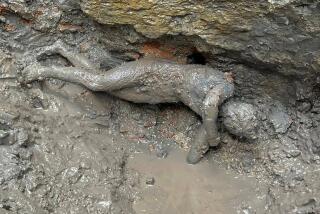Statue of Constantine is discovered among Roman ruins
ROME â A sewer might be no place for an emperor, but it is precisely from an ancient drainage system that archeologists have dug up a large marble sculpture of Constantine, one of Romeâs greatest leaders.
Archeologists found the 24-inch-tall head last week while clearing a sewer in the Roman Forum, the center of public life in the ancient city, said Eugenio La Rocca, superintendent for Romeâs monuments.
âWe canât be sure of why it was put there,â La Rocca said at a Thursday news conference during which authorities showed the bust.
One possibility is that the sculpture of the man who reunited the Roman Empire in the early 4th century and ended years of persecution against Christians was unceremoniously used later to clear a blocked sewer, he said.
La Rocca called the statue a rare find, saying that its insertion in the sewer probably saved it from the plundering the Forum suffered after the fall of the Roman Empire in the 5th century.
âMany portraits have been found in Rome, but these days itâs not easy to find one, especially of this size and so well preserved,â he said.
Experts confirmed that the sculpture portrays Constantine by comparing it to coins and two other giant heads of the emperor that are kept in Romeâs Capitoline Museums, La Rocca said. The Carrara marble head probably belonged to a statue of the emperor in full armor and was erected in the part of the Forum built by the emperor Trajan after Constantine conquered Rome from a rival in AD 312.
The style and stern features used in all of Constantineâs portraits also recall the traits of Trajan, who expanded the empire to its maximum size in the early 2nd century.
âTrajan was the greatest emperor and Constantine considered him a model,â La Rocca said
During his reign, which lasted from 306 to 337, Constantine tried to stop the fracturing of the empire and sought to restore it to its ancient glory.
Although not a Christian himself, he ended the frequent waves of anti-Christian persecutions by proclaiming religious freedom throughout his lands. He also moved the empireâs capital to Constantinople -- todayâs Istanbul -- closer to the eastern borders threatened by the barbarian invasions.
La Rocca said that restorers would now take charge of the work, which will probably be put on display next year in a museum being built in the Roman Forum.
More to Read
Sign up for Essential California
The most important California stories and recommendations in your inbox every morning.
You may occasionally receive promotional content from the Los Angeles Times.










